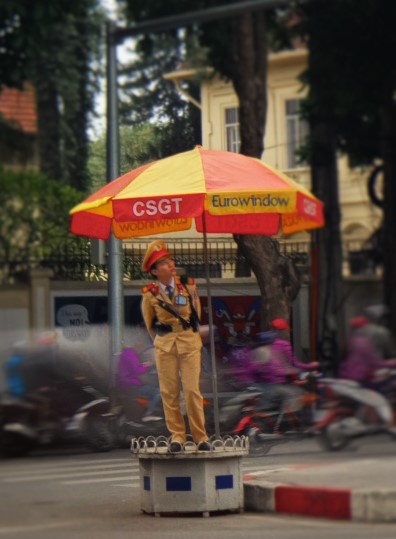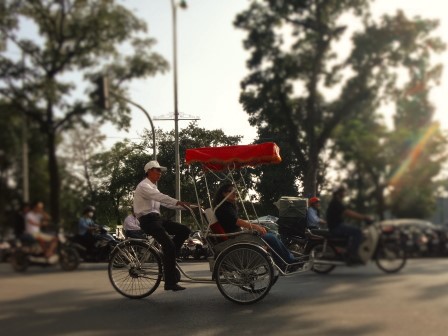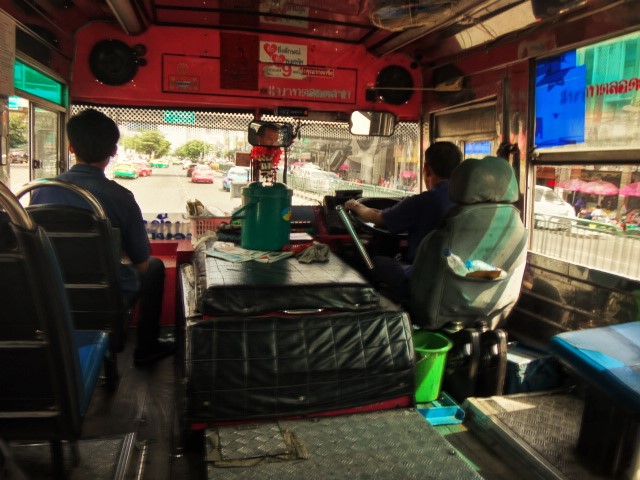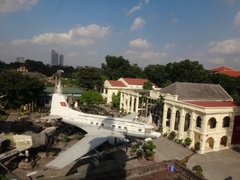They will cause an adrenaline rush, they will make you laugh, they will confuse you, frustrate you and a lot more… and that is the whole beauty of it.
So you landed in Noi Bai International Airport, you paid for you Visa, took your luggage and you think – ‘I’m ready for it, Hanoi here I come’.
Best Hanoi Airport Transportation Options
Being at the airport means that you are around 30 kilometres away from Hanoi City Centre. If you did your research you know that these are your options to get to the city:
You can pay between 300,000 - 500,000 Vietnamese Dong (€15-20) for a Taxi or 40,000 VND (€1.7) for an airport shuttle bus. But being a real explorer you choose to use the public transport and pay only 5000 VND (€0.22) - how is that for a cheap ride?!
When you exit through the arrivals gate, turn right and walk along for around 100 metres. You will see a large parking with public yellow-red buses across the road. All you need to do to reach it is get through taxi drivers offering their service right outside the airport.
Then walk pass a parked private shuttle bus whose workers will try to convince you that they are the only bus company that can take you to Hanoi. Just smile and keep on walking. Cross the street, and jump into a bus number 17 to get to Long Bien Bus station in the city Centre.
You are on the way! You excitedly glance through the bus windows eager to start your new adventure. An hour later bus arrives to Long Bien station, you get up and make your way out onto a busy road, and there you are instantly hit by a wall of sounds… welcome to Hanoi where a perpetual cacophony of sounds travels through the streets of this lively city from dawn to dusk.
That’s perfectly fine… you can take it, with a backpack on your back you are ready to make your way to the hotel. All its left is to decide whether you will be walking or you will take a rickshaw taxi.
Getting Around Hanoi

Hanoi is one of the top places to see in Vietnam but moving around the city can be a real challenge, especially for a westerner. At first it seems to look normal, you will notice traffic lights, roundabouts, zebra crossings, footpaths and sometimes even police managing the traffic flow.
That impression of a well-organized setup doesn’t mean anything, or at least not what we think it does. Traffic flow in here seems to be sort of a surprisingly complex and chaotic setup, especially in the Old Quarter.
Here everything wakes up to life quite early and by 7am streets are full of scooters, footpaths disappear becoming a part of a shop, workshop, parking or a restaurant and this is the way it is until late in the evening. If at this stage you decided to take a rickshaw to slowly drive you to your hotel you will experience the hectic rush and noise but you will be ‘safe’ sitting in a comfortable little cabin able to observe everything around you.
But firstly, you are on a budget, and secondly you think that this is not the best way to get to know the place. You choose to walk…
You already noticed there are no footpaths available, you merge with a street traffic and start your walk. Observation is the key to survival and to really take advantage of your choice. Try to imagine that… Being now part of the road traffic you walk along passing cars and speeding scooters.
There are no rules and regulations in it, if you look carefully at tourists passing by you can clearly see who has been here for longer and is confidently walking along and who just arrived and is awkwardly trying to make their way along the road jumping at every horn sound and every moped passing by so close that they can feel the warmth coming out from the exhaust.
As you stroll along, with the corner of your eye you see millions of sparks bursting in all directions, you turn you head and there he is on the corner of a busy narrow road, a blacksmith sitting on the footpath and working through red hot metal; you turn your head the other way and you see a Vietnamese women sitting on the footpath surrounded by pots full of stir-frying tofu for sale, beside her a lady is selling oranges and bananas from her bicycle.
You take another step and you come across a street painter selling his art work. Seconds later, around the corner you come across a fantastic postmodern electrical art piece on public display. After stopping and gazing up for a moment the realisation dawns that this is in fact a Vietnamese standard operating electricity junction…

Amazed by all this fantastic experience you almost walk pass your destination. Luckily when stopping to admire the ‘electrical art’ you quickly glance at your phone and you see that all you need to do now to get to your hotel is to cross the street.
Do not wait for a gap between scooters, do not hope they will stop and let you pass. This very act of crossing the street is like a culmination of your experience, a free adrenaline rush that you will get every time you try to cross the street in Vietnam.
There are many advices, but the best and safest way to go about it, especially when it is your first time, is to wait for a local crossing the street and just follow him…slowly start walking across, steady pace, straight line and you will see how the traffic just flows around you. This apparent chaos has method to its madness.
You arrived to you hotel, your heart is still pumping from all these captivating experiences, you close your eyes …Welcome to Hanoi!
Yeah, this city is really alive! Walking along these streets you can experience a whole spectrum of events. Everything is happening right here and right now.
There is a constant and completely random intermixture of events happening in between all these rushing vehicles and people walking: selling, cooking, haggling, painting, forging…
An astounding blend of human energy creating city life. It is your choice whether you want to pay the price and use fast and comfortable taxis, explore the joy of being driven by a rickshaw driver, risk and rent a scooter or try your luck walking the streets of Hanoi.
Whichever way you pick you will be able to experience Hanoi and what is has to offer, the only difference will be in the intensity of this experience.
More Tips
- Do not buy any bus tickets at the airport or from random sellers, make your way straight to the public bus station. There you pay to the bus driver directly and you receive a ticket.
- Sometimes if you have too much luggage the bus driver can refuse you entry or demand an additional ticket for your luggage but it still is going to be much cheaper than using any other transport.
- Taking a public bus means that you need to get to the hotel by yourself as the bus will only stop at designated bus stops.
- Taking a private shuttle bus you might pay more and be cramped but after long journey you will be taken directly to your hotel.
- You can buy a Vietnamese sim card at the airport.
- Do not use free tourist maps to find your way around the Old Quarter, they are totally unreliable. Instead, use google maps that is very useful as well when you are trying to haggle you fare with the rickshaw or a taxi driver.
- If using private transport make sure you clearly agree the price in VND before you start your journey.
- If you are backpacking Vietnam the cheapest accommodation is in the Old Quarter of Hanoi.
Go Explore Hanoi
Hanoi is one of the best places to go in south east Asia if you love big noisy hectic cities. If you don't want the hassle of arranging transport and everything by yourself search Vietnam tours.
By Agatha Mcdonagh
Related Pages








